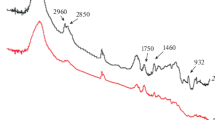A poly(lactic acid)/poly(trimethylene terephthalate) (PLA/PTT) composite was prepared by melt blending to improve the PTT crystallization rate. Morphology analysis of PLA/PTT fractured surfaces demonstrated the compatibility of its components. Thermogravimetric analysis revealed that the thermodegradation of a PLA/PTT sample was higher than that of PLA. Differential scanning calorimetry was used to evaluate the crystallization behavior. The Avrami equation described the isothermal crystallization kinetics. The Hoffman–Weeks parameters indicated that the PLA presence increased slightly the PTT nucleation. The tests of PLA, PTT, and PLA/PTT specimens in tension showed that a percent elongation of the PLA/PTT composite was between that of PLA and PTT; however, the tensile strength of the PLA/PTT composite was similar to that of PLA.









Similar content being viewed by others
References
S.-L. Yang, Z.-H. Wu, W. Yang, et al., “Thermal and mechanical properties of chemical cross-linked polylactide (PLA),” Polym. Test., 27, No. 8, 957–963 (2008).
X. He and D. Yang, “Banded spherulites grown from poly(trimethylene terephthalate) solution-cast film,” J. Wuhan Univ. Technol., 23, No. 6, 791–794 (2008).
H. Chuah, “Orientation and structure development in poly(trimethylene terephthalate) tensile drawing,” Macromolecules, 34, No. 20, 6985–6993 (2001).
S. Grebowicz, H. Brown, H. Chuah, et al., “Deformation of undrawn poly(trimethylene terephthalate) (PTT) fibers,” Polymer, 42, No. 16, 7153–7160 (2001).
J. Zhang, “Study of poly(trimethylene terephthalate) as an engineering thermoplastics material,” J. Appl. Polym. Sci., 91, No. 3, 1657–1666 (2004).
C.-H. Tsou, W.-S. Hung, C.-S. Wu, et al., “New composition of maleic-anhydride-grafted poly(lactic acid)/rice husk with methylenediphenyldiisocyanate,” Mater. Sci.-Medzg., 20, No. 4, 446–451 (2015).
H. B. Ravikumar, C. Ranganathaiah, G. N. Kumaraswamy, and S. Thomas, “Positron annihilation and differential scanning calorimetric study of poly(trimethylene terephthalate)/EPDM blends,” Polymer, 46, No. 7, 2372–2380 (2005).
C.-H. Tsou, H.-T. Lee, M. De Guzman, et al., “Synthesis of biodegradable polycaprolactone/polyurethane by curing with H2O,” Polym. Bull., 72, No. 7, 1545– 1561 (2015).
A. J. Oshinski, H. Keskkula, and D. R. Paul, “Rubber toughening of polyamides with functionalized block copolymers: 1. Nylon-6,” Polymer, 33, No. 2, 268–283 (1992).
C.-H. Tsou, H.-T. Lee, W.-S. Hung, et al., “Synthesis and properties of antibacterial polyurethane with novel Bis(3-pyridinemethanol) silver chain extender,” Polymer, 85, 96–105 (2016).
C.-H. Tsou, H.-T. Lee, H.-A. Tsai, et al., “Synthesis and properties of biodegradable polycaprolactone/polyurethanes by using 2,6-pyridinedimethanol as a chain extender,” J. Polym. Degrad. Stabil., 98, No. 2, 643–650 (2013).
C.-Y. Tsou, C.-L. Wu, C.-H. Tsou, et al., “Biodegradable composition of poly(lactic acid) from renewable wood flour,” Polym. Sci. Ser. B+, 57, No. 5, 473–480 (2015).
P. A. Tzika, M. C. Boyce, and D. M. Parks, “Micromechanics of deformation in particle-toughened polyamides,” J. Mech. Phys. Solids, 48, No. 9, 1893–1929 (2000).
C.-H.Tsou, H.-T. Lee, W.-S. Hung, et al., “Effects of different metals on the synthesis and properties of waterborne polyurethane composites containing pyridyl units,” Polym. Bull., DOI 10.1007/s00289-016-1767-3 (2016).
M.-C. Yang, B.-J. Kao, M.-C. Suen, et al., “The properties and a new preparation of ethylene propylene dienemonomer/montmorillonite nanocomposites,” Polym. Polym. Compos., 23, No. 3, 181–190 (2015).
C. Zhou, M. Chen, Z. Y. Tan, et al., “The influence of arrangement of St in MBS on the properties of PVC/MBS blends,” Eur. Polym. J., 42, No. 8, 1811–1818 (2006).
C.-H. Tsou, M.-C. Suen, W.-Y. Wu, et al., “Crystallization behavior and tensile property of poly (trimethyleneterephthalate)/styrene-ethylene-buthylene-styrene composites,” J. Wuhan Univ. Technol., 31, No. 2, 474–480 (2016).
C.-H. Tsou, M.-C. Suen, W.-H. Yao, et al., “Preparation and characterization of bioplastic-based green renewable composites from tapioca with acetyl tributyl citrate as plasticizer,” Materials, 7, No. 8, 5617–5632 (2014).
K. Wang, Y. Chen, and Y. Zhang, “Effects of organoclay platelets on morphology and mechanical properties in PTT/EPDM-g-MA/organoclay ternary nanocomposites,” Polymer, 49, No. 15, 3301–3309 (2008).
D. Juárez, S. Ferrand, O. Fenollar, et al., “Improvement of thermal inertia of styrene-ethylene/butylenestyrene (SEBS) polymers by addition of microencapsulated phase change materials (PCMs),” Eur. Polym. J., 47, No. 2, 153–161 (2011).
C.-H. Tsou, B.-J. Kao, M.-C. Yang, et al. “Biocompatibility and characterization of polylactic acid/styrene-ethylene-butylene-styrene composites,” Biomed. Mater. Eng., 26, Suppl. 1, S147–S154 (2015).
N. R. Savadekar and S. T. Mhaske, “The effect of vulcanized thermoplastics and SEBS on the impact strength of PPT,” Polym.-Plast. Technol., 49, No. 15, 1499–1505 (2010).
H. Zou, L. Wang, C. Yi, and H. Gan, “Thermal properties and non-isothermal crystallization behavior of poly(trimethylene terephthalate)/poly(lactic acid) blends,” Polym. Int., 60, No. 9, 1349–1354 (2011).
M. Pyda, A. Boller, J. Grebowicz, et al., “Heat capacity of poly(trimethylene terephthalate),” J. Polym. Sci. Polym. Phys., 36, No. 14, 2499–2511 (1998).
M. Avrami, “Kinetics of phase change. I: General theory,” J. Chem. Phys., 7, No. 12, 1103–1112 (2004).
P. Srimoaon, N. Dangseeyun, and P. Supaphol, “Multiple melting behavior in isothermally crystallized poly(trimethylene terephthalate),” Eur. Polym. J., 40, No. 3, 599–608 (2004).
S. I. Han, S. W. Kang, B. S. Kim, et al., “A novel polymeric ionomer as a potential biomaterial: Crystallization behavior, degradation, and in-vitro cellular interactions,” Adv. Funct. Mater., 15, 367–374 (2005).
C.-H. Tsou, B.-J. Kao, M.-C. Suen, et al., “Crystallization behavior and biocompatibility of poly(butylene succinate)/poly(lactic acid) composites,” Mater. Res. Innov., 18, No. S2, S2-372–S2-376 (2014).
N. Dangseeyun, P. Supaphol, and M. Nithitanakul, “Thermal, crystallization, and rheological characteristics of poly(trimethylene terephthalate)/poly(butylene terephthalate) blends,” Polym. Test., 23, No. 2, 187–194 (2004).
Author information
Authors and Affiliations
Corresponding author
Additional information
Translated from Problemy Prochnosti, No. 1, pp. 190 – 199, January – February, 2017.
Rights and permissions
About this article
Cite this article
Tsou, CY., Wu, CL., Tseng, YC. et al. Isothermal Crystallization Kinetics Effect on the Tensile Properties of PLA/PTT Polymer Composites. Strength Mater 49, 171–179 (2017). https://doi.org/10.1007/s11223-017-9855-7
Received:
Published:
Issue Date:
DOI: https://doi.org/10.1007/s11223-017-9855-7




